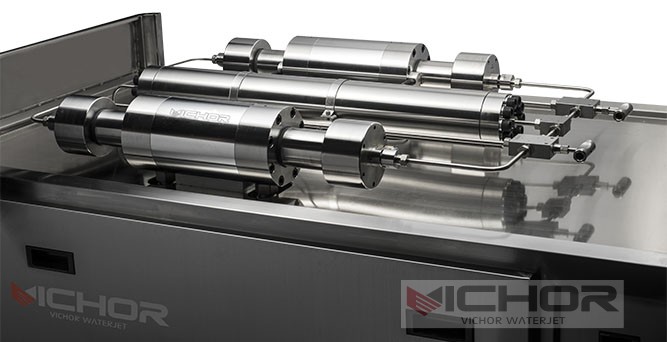What Are the 5 Key Aspects of Waterjet Pumps & Systems?
Waterjet pumps & systems have revolutionized various industries by offering precise, efficient, and versatile cutting and cleaning solutions. Utilizing high-pressure water streams, sometimes mixed with abrasives, these systems can handle materials ranging from soft composites to hardened metals. Understanding the intricacies of waterjet pumps & systems is crucial for optimizing their performance and ensuring long-term reliability. In this article, we will delve into five essential aspects that define these systems, covering their operation, types, applications, benefits, and maintenance. Whether you are new to this technology or looking to enhance your knowledge, this breakdown will provide valuable insights into how waterjet pumps & systems can meet diverse industrial needs.
How Waterjet Pumps & Systems Function
Waterjet pumps & systems operate on the principle of pressurizing water to extremely high levels, typically between 30,000 to 90,000 psi, and directing it through a small nozzle to create a focused jet. This jet can cut or clean surfaces with remarkable precision. The core component is the pump, which intensifies water pressure using either an intensifier pump or a direct drive pump. In intensifier-based waterjet pumps & systems, hydraulic fluid drives a piston that amplifies water pressure, while direct drive systems use electric motors to achieve similar results. The pressurized water then travels through high-pressure tubing to the cutting head, where it may be mixed with abrasives for tougher materials. The entire process is controlled by sophisticated software that manages pressure, flow rate, and movement, ensuring accuracy in tasks like shaping metal or etching glass. Understanding this functionality is key to appreciating why waterjet pumps & systems are favored for their non-thermal nature, which prevents material distortion and allows for cold cutting.
Types of Waterjet Pumps & Systems Available
When selecting waterjet pumps & systems, it’s important to recognize the main categories: pure waterjet systems and abrasive waterjet systems. Pure waterjet systems use only pressurized water and are ideal for softer materials like foam, rubber, or food products. They are commonly used in industries requiring delicate cuts without contamination. On the other hand, abrasive waterjet pumps & systems incorporate garnet or other abrasives into the water stream, enabling them to cut through hard substances such as steel, stone, or ceramics. These systems include an abrasive hopper and mixing chamber, making them versatile for heavy-duty applications. Additionally, waterjet pumps & systems can be classified by their pump mechanism—intensifier pumps, known for high pressure and consistency, and direct drive pumps, which are more compact and efficient for continuous operation. Each type of waterjet pumps & systems offers distinct advantages, so choosing the right one depends on factors like material hardness, required cut quality, and operational costs.
Common Applications of Waterjet Pumps & Systems
The versatility of waterjet pumps & systems makes them suitable for a wide range of industries. In manufacturing, they are used for precision cutting of components in aerospace, automotive, and electronics, where tight tolerances are critical. For instance, waterjet pumps & systems can shape turbine blades or circuit boards without generating heat-affected zones. In the construction sector, these systems cut tiles, granite, and other building materials with intricate designs. The food industry employs waterjet pumps & systems for portioning products like meat or pastries, as the water-only method ensures hygiene and prevents cross-contamination. Moreover, waterjet pumps & systems are integral in art and design for creating detailed sculptures and installations from various mediums. Their ability to handle diverse materials without tool wear or environmental hazards underscores why waterjet pumps & systems are a go-to solution across fields, promoting efficiency and innovation.
Benefits of Using Waterjet Pumps & Systems
Adopting waterjet pumps & systems brings numerous advantages, starting with their precision and flexibility. Unlike mechanical cutters or lasers, waterjet pumps & systems produce no heat, eliminating risks of thermal distortion and allowing cuts in heat-sensitive materials. This cold-cutting capability also reduces the need for secondary processing, saving time and resources. Additionally, waterjet pumps & systems are environmentally friendly, as they primarily use water and natural abrasives, minimizing waste and hazardous byproducts. The versatility of waterjet pumps & systems means one machine can handle multiple materials, reducing equipment costs and floor space. Operators also benefit from the ease of automation, as modern waterjet pumps & systems integrate with CAD/CAM software for seamless, repeatable results. Overall, the efficiency, safety, and adaptability of waterjet pumps & systems contribute to lower operational expenses and higher productivity in various settings.
Maintenance Tips for Waterjet Pumps & Systems
Proper maintenance is essential for maximizing the lifespan and performance of waterjet pumps & systems. Regular inspections should focus on key components like the pump, nozzles, and high-pressure seals to prevent leaks and wear. For instance, in waterjet pumps & systems, the intensifier pump may require periodic oil changes and filter replacements to maintain pressure levels. Nozzles and orifices should be checked for erosion and cleaned to ensure consistent jet quality. It’s also crucial to monitor water quality, as impurities can damage the system; using filtration systems can mitigate this. Lubricating moving parts and calibrating pressure settings according to manufacturer guidelines will help avoid downtime. Implementing a scheduled maintenance plan for waterjet pumps & systems not only enhances reliability but also reduces repair costs, ensuring they operate at peak efficiency for years.
Future Trends in Waterjet Pumps & Systems
The evolution of waterjet pumps & systems is driven by advancements in technology and sustainability. Emerging trends include the integration of IoT and AI for predictive maintenance, where sensors in waterjet pumps & systems monitor performance in real-time and alert operators to potential issues. This smart technology can optimize energy use and reduce waste, aligning with green initiatives. Additionally, developments in pump efficiency are making waterjet pumps & systems more compact and less noisy, expanding their use in sensitive environments. There is also a growing focus on recycling water and abrasives in waterjet pumps & systems to minimize environmental impact. As industries demand higher precision and automation, waterjet pumps & systems are likely to incorporate more robotic elements and advanced software, further enhancing their capabilities and accessibility.
In summary, waterjet pumps & systems represent a powerful technology that combines precision, versatility, and environmental benefits. By understanding their operation, types, applications, advantages, and maintenance needs, users can fully leverage their potential. As innovations continue to shape this field, waterjet pumps & systems will remain at the forefront of industrial cutting and cleaning solutions, offering reliable performance across diverse sectors.
Frequently Asked Questions About Waterjet Pumps & Systems
Q1: What are the primary components of waterjet pumps & systems?
A1: The main components include the high-pressure pump, which generates water pressure; the intensifier or direct drive mechanism; the cutting head with nozzles; abrasive delivery systems (for abrasive jets); high-pressure tubing; and control software. These elements work together in waterjet pumps & systems to produce a focused water stream for cutting or cleaning.
Q2: How do I choose between pure and abrasive waterjet pumps & systems?
A2: Your choice depends on the materials you need to process. Pure waterjet pumps & systems are best for soft materials like foam or food, as they use water only. Abrasive waterjet pumps & systems are suitable for hard materials like metal or stone, as they mix abrasives with water for enhanced cutting power. Consider factors like material hardness, cut quality, and operational costs when selecting waterjet pumps & systems.
Q3: What safety precautions are necessary when operating waterjet pumps & systems?
A3: Always wear protective gear, such as gloves and goggles, to guard against high-pressure streams. Ensure proper training for operators to handle emergency shut-offs and pressure adjustments. Regularly inspect waterjet pumps & systems for leaks or wear, and follow manufacturer guidelines to prevent accidents. Keeping the work area clear and using enclosures can also enhance safety with waterjet pumps & systems.
Q4: Can waterjet pumps & systems be used for underwater applications?
A4: Yes, specialized waterjet pumps & systems are designed for underwater use, such as in offshore industries or marine salvage. These systems are built with corrosion-resistant materials and sealed components to operate effectively in submerged environments, maintaining their cutting precision without compromising safety.
Q5: How often should I perform maintenance on waterjet pumps & systems?
A5: It’s recommended to conduct daily checks for leaks and nozzle condition, weekly inspections of filters and pumps, and comprehensive servicing every 500 hours of operation or as per the manufacturer’s schedule. Regular maintenance of waterjet pumps & systems helps prevent breakdowns and ensures consistent performance, extending the equipment’s lifespan.
continue reading
Related Posts
- 1155 words5.8 min read



